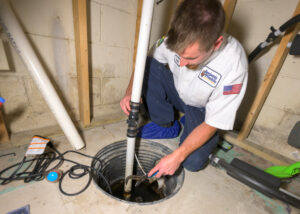Sump Pump Basics
Let’s start with the basics. Sump pumps are pumps that sit in a pit in your basement or crawl space.
There are two main types: ones that sit up high (pedestal pumps) and ones that sit down low in the water (submersible pumps). They both do the same job, but they’re built differently to fit different pits.

How to Tell if a Sump Pump is Clogged
The easiest way to know if your sump pump is clogged is to see if it’s working right. When it rains, if your pump is getting rid of the extra water from your home, it’s probably not clogged.
But if it’s not doing its job and you end up with water in your basement, then there’s likely a clog causing the problem.
Common Reasons For Sump Pump Clogs
If your sump pump doesn’t have a lid, it’s at risk of getting clogged and dirty over time. This is a common problem in many basements across the country.
Without a lid, debris, dirt, and other gunk can easily find their way into the sump pit, leading to clogs. Over time, these clogs can slow down or completely stop the sump pump from working effectively.
Additionally, in colder climates, another common cause of sump pump clogs is freezing of the discharge pipe during winter. When the temperature drops, the water in the discharge pipe can freeze, blocking the flow of water from the sump pump.
To prevent this issue, it’s essential to install a discharge pipe that angles downward or bury it underground below the frost line. This allows the water to drain properly without the risk of freezing, ensuring your sump pump can operate smoothly even in cold weather.
How to Unclog a Sump Pump
Here’s an easy-to-follow guide on how to unclog a sump pump:
- Turn off the Power: Safety first! Before you start working on the sump pump, make sure to turn off the power to avoid any accidents.
- Check for Visible Blockages: Locate the discharge line of the sump pump and inspect it for any visible blockages. Remove any debris you can see.
- Use a Plumber’s Snake: If you can’t clear the blockage by hand, use a plumber’s snake. Insert it into the discharge line until you feel resistance, then twist it back and forth until it breaks through the clog.
- Test the Water Flow: Turn the sump pump back on and observe the water flow from the discharge line. If it’s still not flowing properly, repeat steps 2 and 3 until the blockage is cleared.
- Flush with Hot Water: Once the clog is cleared, flush the drain pipe with clean hot water to ensure there are no remaining blockages.
- Inspect the Pump: Finally, check the sump pump itself to ensure it’s working correctly. Examine the float switch and pump motor to make sure they’re functioning properly.
Remember, if you’re unsure or uncomfortable performing these steps yourself, it’s best to call a professional for assistance. Keeping your sump pump clear and well-maintained is crucial for preventing basement floods and other household problems.

Conclusion
Taking care of your sump pump is important to keep your basement dry. By following these simple steps, you can make sure it keeps doing its job, even during the toughest storms.
And if you ever need a hand, our team at All Seasons is here to help. We’ll make sure your sump pump is in tip-top shape so you can rest easy knowing your home is protected.
